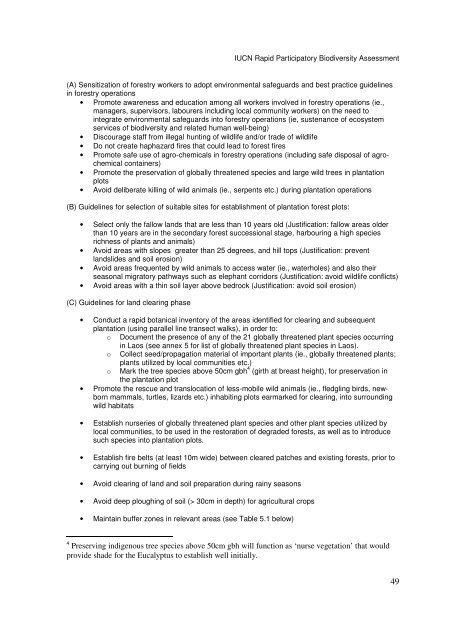Part 1 – A Rapid Participatory Biodiversity Assessment - IUCN
Part 1 – A Rapid Participatory Biodiversity Assessment - IUCN
Part 1 – A Rapid Participatory Biodiversity Assessment - IUCN
Create successful ePaper yourself
Turn your PDF publications into a flip-book with our unique Google optimized e-Paper software.
<strong>IUCN</strong> <strong>Rapid</strong> <strong>Part</strong>icipatory <strong>Biodiversity</strong> <strong>Assessment</strong><br />
(A) Sensitization of forestry workers to adopt environmental safeguards and best practice guidelines<br />
in forestry operations<br />
• Promote awareness and education among all workers involved in forestry operations (ie.,<br />
managers, supervisors, labourers including local community workers) on the need to<br />
integrate environmental safeguards into forestry operations (ie, sustenance of ecosystem<br />
services of biodiversity and related human well-being)<br />
• Discourage staff from illegal hunting of wildlife and/or trade of wildlife<br />
• Do not create haphazard fires that could lead to forest fires<br />
• Promote safe use of agro-chemicals in forestry operations (including safe disposal of agrochemical<br />
containers)<br />
• Promote the preservation of globally threatened species and large wild trees in plantation<br />
plots<br />
• Avoid deliberate killing of wild animals (ie., serpents etc.) during plantation operations<br />
(B) Guidelines for selection of suitable sites for establishment of plantation forest plots:<br />
• Select only the fallow lands that are less than 10 years old (Justification: fallow areas older<br />
than 10 years are in the secondary forest successional stage, harbouring a high species<br />
richness of plants and animals)<br />
• Avoid areas with slopes greater than 25 degrees, and hill tops (Justification: prevent<br />
landslides and soil erosion)<br />
• Avoid areas frequented by wild animals to access water (ie., waterholes) and also their<br />
seasonal migratory pathways such as elephant corridors (Justification: avoid wildlife conflicts)<br />
• Avoid areas with a thin soil layer above bedrock (Justification: avoid soil erosion)<br />
(C) Guidelines for land clearing phase<br />
• Conduct a rapid botanical inventory of the areas identified for clearing and subsequent<br />
plantation (using parallel line transect walks), in order to:<br />
o Document the presence of any of the 21 globally threatened plant species occurring<br />
in Laos (see annex 5 for list of globally threatened plant species in Laos).<br />
o Collect seed/propagation material of important plants (ie., globally threatened plants;<br />
plants utilized by local communities etc.)<br />
o Mark the tree species above 50cm gbh 4 (girth at breast height), for preservation in<br />
the plantation plot<br />
• Promote the rescue and translocation of less-mobile wild animals (ie., fledgling birds, newborn<br />
mammals, turtles, lizards etc.) inhabiting plots earmarked for clearing, into surrounding<br />
wild habitats<br />
• Establish nurseries of globally threatened plant species and other plant species utilized by<br />
local communities, to be used in the restoration of degraded forests, as well as to introduce<br />
such species into plantation plots.<br />
• Establish fire belts (at least 10m wide) between cleared patches and existing forests, prior to<br />
carrying out burning of fields<br />
• Avoid clearing of land and soil preparation during rainy seasons<br />
• Avoid deep ploughing of soil (> 30cm in depth) for agricultural crops<br />
• Maintain buffer zones in relevant areas (see Table 5.1 below)<br />
4 Preserving indigenous tree species above 50cm gbh will function as ‘nurse vegetation’ that would<br />
provide shade for the Eucalyptus to establish well initially.<br />
49

















